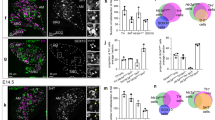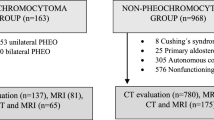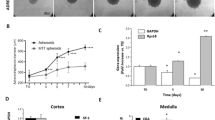Abstract
ABNORMALLY high rates of excretion of 4-hydroxy-3-methoxymandelic acid, a metabolite of both adrenaline and noradrenaline, are now well known to be associated with phaeochromocytoma and sympathoblastoma1–3. A convenient chromatographic technique enabling the substance to be estimated visually has been described elsewhere3. It seemed of interest to examine the possibility that the method would prove sufficiently sensitive to detect the increased secretions of the catecholamines to be anticipated in subjects exposed to stress.
Similar content being viewed by others
Article PDF
References
Armstrong, M. D., and McMillan, A., Fed. Proc., 16, 146 (1957).
Sandler, M., and Ruthven, C. J. R., Lancet, ii, 114 (1959).
Robinson, R., Ratcliffe, J., and Smith, P., J. Clin. Path. (in the press).
Shaw, K. N. F., McMillan, A., and Armstrong, M. D., J. Biol. Chem., 226, 255 (1957).
Author information
Authors and Affiliations
Rights and permissions
About this article
Cite this article
ROBINSON, R., SMITH, P. Urinary Phenols in Stress. Nature 186, 240 (1960). https://doi.org/10.1038/186240a0
Issue date:
DOI: https://doi.org/10.1038/186240a0
This article is cited by
-
Physical work capacity and physical conditioning in paraplegic patients
Spinal Cord (1973)
-
Untersuchungen über Physiologie und Pathophysiologie des sympathikoadrenalen Systems durch Bestimmung der Vanillin-Mandelsäure-Ausscheidung im Harn mit dünnschichtehromatographischer Technik
Archiv für Kreislaufforschung (1966)
-
Urinary Phenolic Acids in Infective Hepatitis
Nature (1962)
-
Tyrosyluria in Human Subjects
Nature (1961)



